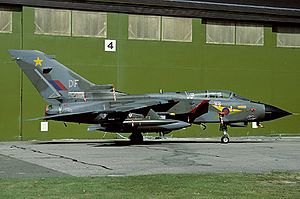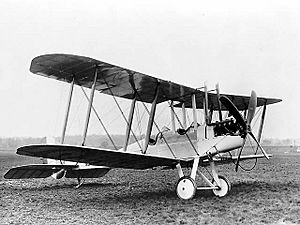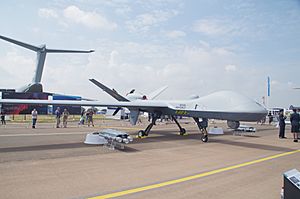No. 31 Squadron RAF facts for kids
Quick facts for kids No. 31 Squadron RAF |
|
|---|---|

Squadron badge
|
|
| Active | 11 October 1915 – 1 April 1918 (RFC) 1 April 1918 – 30 September 1946 (RAF) 1 November 1946 – 31 December 1947 19 July 1948 – 31 March 1971 7 October 1971 – 14 March 2019 11 October 2023 – |
| Country | |
| Branch | |
| Type | Flying squadron |
| Role | ISR & Attack |
| Home station | RAF Waddington |
| Nickname(s) | 'Goldstars' |
| Motto(s) | In cælum indicum primus (Latin for 'First into Indian skies') |
| Mascot(s) | Flt Lt, The Right Honourable, "Arris Arietis" Esq (Panda) |
| Anniversaries | 11 Oct |
| Current Aircraft | Protector RG.1 |
| Battle honours |
|
| Insignia | |
| Squadron badge heraldry | In front of a wreath of laurel, a mullet. The badge was based on an unofficial emblem, the mullet indicating the Star of India and the squadron's claim to being the first military unit to fly in India. Approved by King George VI in June 1937. |
| Squadron Roundel |  |
| Squadron codes | ZA (Apr 1939 – Sep 1939) CB (Jul 1948 – Mar 1955) VS (Jul 1948 – 1951) DA–DZ (Jun 1976–Mar 2019) |
Number 31 Squadron, also known as the Goldstars, is a famous part of the Royal Air Force (RAF). This squadron holds a special place in history because it was the first military unit to fly in India. They were based there from 1915 to 1947.
During the Cold War, the Goldstars were stationed in West Germany. They flew from airfields like RAF Laarbruch and RAF Brüggen. From 1984 to 2019, they flew the powerful Panavia Tornado GR1/4 aircraft. They were first at RAF Brüggen, then moved to RAF Marham in Norfolk in 2001.
No. 31 Squadron was officially stopped on March 14, 2019. However, they will start up again in October 2023 at RAF Waddington in Lincolnshire. By 2024, they plan to use the General Atomics Protector RG1, which is a remotely piloted aircraft.
Contents
History of the Goldstars
Early Years and First World War
No. 31 Squadron began on October 11, 1915, at Farnborough. It was part of the Royal Flying Corps. The squadron first used the Royal Aircraft Factory B.E.2c aircraft.
They quickly moved to Risalpur in India on December 26, 1915. In 1917, a small group from the squadron went to Khormaskar in Aden. There, they flew missions to gather information against Ottoman forces.
No. 31 Squadron stayed in India throughout the First World War. They flew aircraft like the B.E.2c, B.E.2e, and the Henri Farman HF.27. Their main job was to support the British Army against local tribes.
Between the World Wars
After the First World War, the squadron took part in the Third Anglo-Afghan War from May to August 1919. They attacked Jalalabad several times and lost three aircraft. In June 1919, they started using only the Bristol F.2B Fighter.
For the next ten years, No. 31 Squadron helped keep peace in the Waziristan and Afghanistan areas. They also supported the British Army in stopping rebellions.
In 1931, the squadron updated their aircraft to the Westland Wapiti Mk.IIa. A big earthquake in Quetta in 1935 made them move to RAF Drigh Road. In 1937, their special badge, which shows a laurel wreath and a mullet, was approved by King George VI.
In 1939, No. 31 Squadron changed its role to bomber-transport. They started using Vickers Valentias. With these new planes, they carried out attacks during the 1939 Waziristan campaign.
Second World War Missions
For the first year and a half of the Second World War, No. 31 Squadron remained in India. In April 1941, they began using Douglas DC-2 aircraft. They flew missions to support RAF Habbaniya during the Anglo-Iraqi War.
After returning to India, the squadron got Douglas Dakota Mk.I planes. When Japan invaded Burma, they flew missions between Calcutta and Rangoon. Their job was to drop supplies for the XIVth Army. After the war, the squadron moved to Java. In 1946, they were stopped in Java but quickly started again in PAF Base Masroor, Mauripur, which was then in British India.
Cold War Operations (1948–1984)
At the end of 1947, the squadron was stopped again. But in July 1948, the Goldstars reformed. They took over the planes and duties of another unit at RAF Hendon. On March 1, 1955, No. 31 Squadron moved to RAF Laarbruch in West Germany. They used English Electric Canberra PR.7 aircraft for taking photos from the air.
On September 13, 1956, the Goldstars received their Squadron Standard, a special flag, for 25 years of service. They took part in a competition in 1958, flying alongside No. 17 Squadron. They won a trophy for their high-altitude photo missions. No. 31 (PR) Squadron was stopped at RAF Laarbruch on March 31, 1971.
In June 1971, the squadron began to prepare for new aircraft, the McDonnell Douglas Phantom FGR.2. Their first Phantom flight was on July 20, 1971. The squadron was officially ready for combat on March 1, 1972. They then went to Decimomannu Air Base in Sardinia for training.
On January 1, 1976, No. 31 Squadron started getting ready for the SEPECAT Jaguar GR.1 strike aircraft. Their Jaguar GR.1s were ready for action on June 30, 1976. By December 1976, No. 31 Squadron was fully ready for combat.
Tornado GR Era (1984–2019)

In September 1984, the Goldstars started using Panavia Tornado GR.1s at RAF Brüggen. They finished changing over from the Jaguar on November 1, 1984. Their main job remained the same, which was to be ready for important missions.
In 1991, No. 31 Squadron led the Tornado GR1/GR1A group during Operation Granby (the first Gulf War). This group included parts of other squadrons. Wing Commander Jeremy Witts, who was in charge, received a special medal for his leadership.
The squadron's role in nuclear strike missions ended in 1994. From 1995, they became experts in stopping enemy air defenses. They used the ALARM Anti Radiation Missile. Only No. 31 Squadron and No. IX (Bomber) Squadrons specialize in this role, and they are known as "Pathfinder" squadrons.
In 1999, the squadron updated to the Tornado GR4. That same year, No. 31 Squadron took part in Operation Engadine, which were NATO operations over the Federal Republic of Yugoslavia. For part of this operation, they were based in Corsica.
No. 31 Squadron was the last RAF squadron to be based at RAF Brüggen in Germany. They moved back to the UK, to RAF Marham in Norfolk, in August 2001. In 2003, the Goldstars were a key part of the Ali Al Salem Air Combat Wing in Kuwait. They flew missions over Iraq during Operation Resonate South and Operation Telic.
No. 31 Squadron became the main RAF Tornado GR4 unit to use the Brimstone anti-tank missile. They started using this weapon at RAF Marham on April 7, 2005.
In 2012, the squadron completed a mission in Afghanistan called Operation Herrick. They provided air support to ground troops. They had a 100% success rate, which was a first for a Tornado squadron on such a mission.
In September 2012, they joined Exercise Shaheen Star in the United Arab Emirates. They trained with the air forces of the UAE, France, and the USA. On August 12, 2014, the Goldstars sent six Tornados to RAF Akrotiri in Cyprus. This was for reconnaissance missions over Mount Sinjar in Iraq. They later went to Kandahar Airfield in Afghanistan for their last Operation Herrick mission. They returned to Marham on November 11, 2014. No. 31 Squadron went back to RAF Akrotiri in February 2015 for their first Operation Shader mission.
On July 10, 2018, nine Tornado GR.4s from No. 31 Squadron and No. IX (B) Squadron flew over London. This was to celebrate the RAF's 100th birthday. On November 13, 2018, a special Tornado GR.4 ZD716 was shown to mark 35 years of Tornado flights. No. 31 Squadron was officially stopped on March 14, 2019, at RAF Marham.
The Protector RG1 Era
No. 31 Squadron will start up again in October 2023 at RAF Waddington in Lincolnshire. They will be equipped with up to sixteen General Atomics MQ-9B aircraft. These are remotely piloted air systems (RPAS), which means they are flown from the ground. In the RAF, they will be known as the Protector RG Mk 1.
Notable Goldstars
Many important people have served in No. 31 Squadron:
- MRAF Sir Arthur 'Bomber' Harris was a pilot and commander. He later became a very important leader in Bomber Command.
- ACM Sir Mike Wigston was a pilot in the squadron and later became the Chief of the Air Staff.
- AM Greg J Bagwell was a Tornado pilot and later a Deputy Commander.
- AM Sir Chris N Harper was a Jaguar pilot and later a very senior officer.
- AM Ian Gale was a pilot and later held important leadership roles in the RAF.
- Air Cdre Paddy Teakle was a navigator and commander. He led the Ali Al Salem Combat Air Wing during the second Gulf War.
- Flt Lt David "Lummie" Lord served most of his career with 31 Sqn. He was later awarded the Victoria Cross, the highest military award, for his bravery during a mission.
- Flt Lt John Peters was a pilot in the squadron. He became famous as a prisoner of war during the first Gulf War.
- Flt Lt Ian 'Abbo' Abson was a Tornado Weapons System Operator. He received a special French military medal twice for his actions in Afghanistan and Libya.
Memorial
To celebrate its 100th birthday, a special memorial for No. 31 Squadron was revealed at the National Arboretum in October 2015.
Affiliations
No. 31 Squadron has connections with:
- HMS Iron Duke (F234) (a Royal Navy ship)
- 3 Regiment Army Air Corps (an Army unit)
- Honourable Company of Air Pilots (a group for pilots)
- 31 (Tower Hamlets) Squadron, Air Training Corps (RAF Air Cadets)
See also
- List of RAF squadrons






